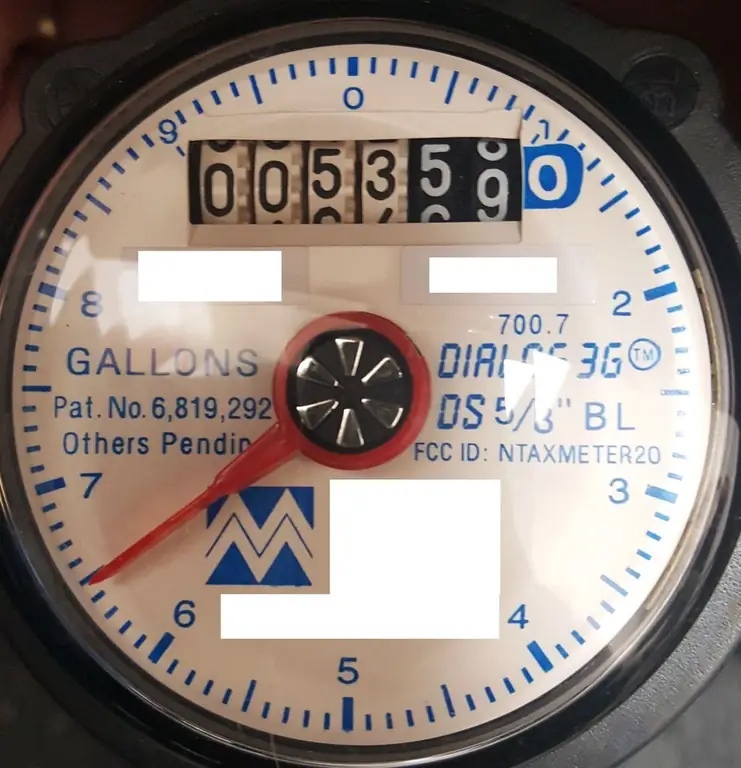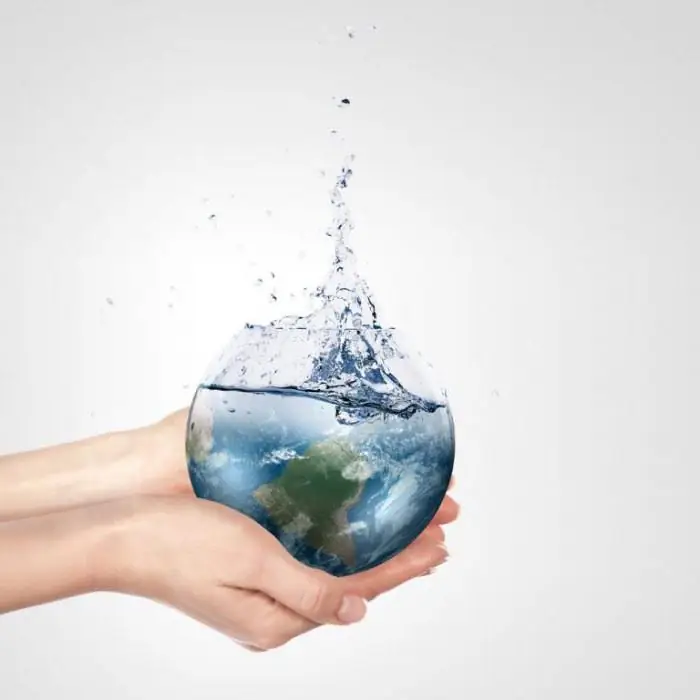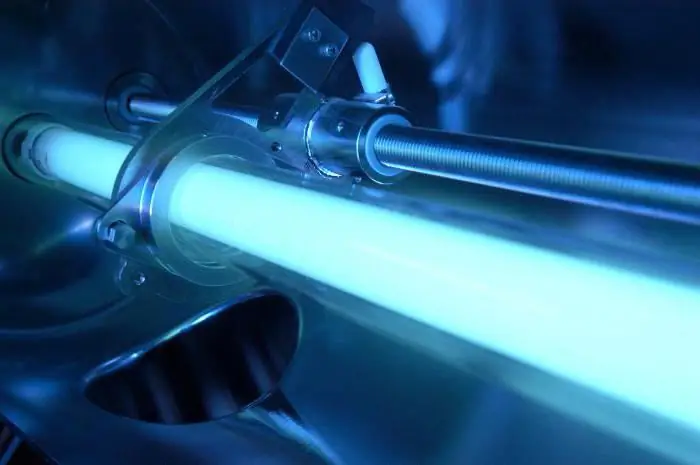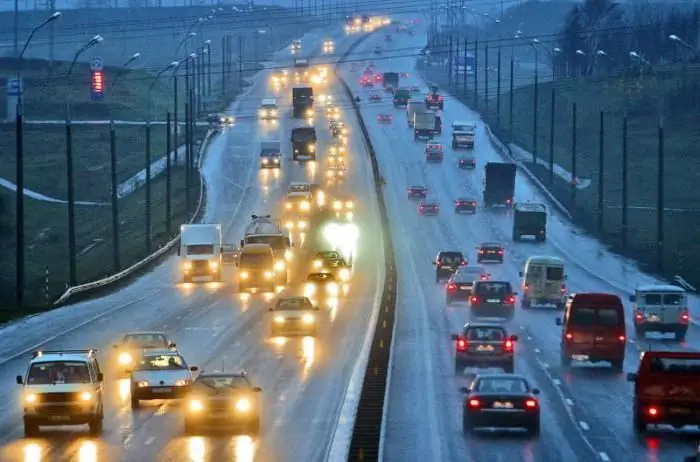2025 Author: Howard Calhoun | [email protected]. Last modified: 2025-01-24 13:10:26
Hydroplaning is one of the most dangerous situations on the road that can happen to every driver. The ability to avoid an unpleasant situation directly depends on the person's awareness of it. Thanks to this article, you can learn about what a water wedge is and how to avoid it.
What is a water wedge on the road
Water wedge is the appearance of a water film between the wheel and the road. During such a situation, at speeds above 40-60 km / h, the car becomes virtually uncontrollable. The grip of the tires with the surface of the coating disappears, the water separates them from each other. Imagine a situation in which you drove onto the ice on summer tires. These are the sensations that appear during the water wedge.

In what conditions can you "catch" a water wedge? Most often this happens when driving through large puddles on highways. Seeing the spill, the driver does not slow down and, with all his might, finds himself in an uncontrollable car for a few seconds. Also, the formation of a water wedge can occur on rutted roads. When it rains on themwater instantly accumulates, which is the reason for skidding.
How dangerous it is
Hydroplaning on the road is much more dangerous than driving on snow or even ice. Winter tires are geared towards poor traction, but water wheels have yet to be invented. Why is the water wedge so insidious?
- Increased stopping distance. During the appearance of a film between the road and the wheel, the braking efficiency is reduced by about three times.
- Loss of control. The most dangerous situation. At high speeds, avoiding a water wedge is almost impossible. Having "caught" this unstable position, you will not confuse it with anything. The car seems to begin to soar above the ground, ceases to respond to the steering wheel. If you are already in such a situation, you can only hope that the car will not go into a skid. Worst of all, when the water wedge works only on one or two wheels, then skidding is definitely inevitable.
- Predicting hydroplaning in advance is impossible, as it depends on too many nuances: the quality of asph alt, tires, speed.

How a water wedge is formed
Oddly enough, but the water wedge most often forms on new highway surfaces with perfect asph alt. On the old road, the moisture that has fallen out quickly leaves through bumps and cracks. And the new road surface becomes a film that retains moisture on the surface. Driving through such sections at high speed, cars often cannot cope with the load and get into an accident. Modern narrow-wheeled vehicles with rain tires may not even feel anything at high speed, since the area of contact with the water will be small and short. But models with wide wheels and old tires can go into a skid at 40 km / h. In order to avoid unpleasant situations, you need to take care of the right tires in advance and check them regularly. Prevention is the best way to deal with hydroplaning.
Water wedge: what to do in such a situation?
You can avoid hydroplaning by carefully monitoring the condition of your tires. They are the main help in safe driving through puddles. Special recesses and grooves help to avoid the “flight” of the wheel, diverting water in time. Don't forget that wheels have an expiration date and tires wear out with every ride. Wheels that have served half their life, the risk of hydroplaning increases by 70%. What else can be done to prevent dangerous situations on the road?
Keep an eye on the condition of the road. During or immediately after rain on the road, you need to be especially careful. At first glance, it may seem that the road is only slightly wet. But in fact, it will be the same thin film that will lead the car to the side. Driving on a wet surface is also not worth it. It is not for nothing that during rainfall, speed limits are posted on all highways, as a rule, no more than 90 km / h. And if you have old tires, then it’s definitely not worth accelerating above 60-70 km.

If you see a puddle ahead, drive aroundwhich is not possible, try to slow down and keep the steering wheel straight. The wheels of the car are most stable in a level position. Trying to swerve after starting hydroplaning will cause your car to behave unexpectedly.
In case of loss of traction in the water wedge, do not apply the brake under any circumstances. Remember that braking is good during traction, but it just isn't there during hydroplaning. Engine braking is the most effective. Release the gas pedal and keep the steering wheel straight - and in this way you will get out of hydroplaning with the least loss.
Advice from experienced drivers

During the off-season, in spring and autumn, the roads are especially dangerous. Tips from experienced drivers to help you avoid trouble and a water wedge:
- If you see that the road is wet, do not overtake everything that moves, observe the speed limit. The old adage "Slow down - you will continue" is still relevant here.
- If you see a rut with water or a puddle ahead, slow down by taking your foot off the gas pedal.
- Keep your distance - not only your car can go into a skid, but also the one that goes ahead. Keeping an optimal distance will protect you and other road users.
- Keep both hands on the steering wheel in the correct position. During hydroplaning, the car becomes uncontrollable and you will most likely need both hands to stabilize the movement.
By following these simple and obvious rules, you can keep control of the situationon the road.

Mistakes of novice drivers
Often, inexperienced beginners don't know what to do when a water wedge occurs. Calmness and confidence determine the correct behavior on the road. The biggest mistake is to start to panic and try to turn the steering wheel and brake during hydroplaning. By doing so, you will not only not correct the situation, on the contrary, worsen it, endangering other road users who are following you.
According to the SDA, the water wedge must be prevented, but if this fails, take the actions indicated above. A clear knowledge of possible solutions to the problem will help you stay calm during unforeseen situations.
Which tires to choose to avoid hydroplaning

When choosing the "right" tires, one should be guided not by beauty or price, but by their functionality. As a rule, on such wheels you can find symbols in the form of a drop or the words Aqua, Water or Rain. They feature deep grooves for water drainage and a special tread pattern. Such tires do not protect 100% from hydroplaning, but still make it possible to drive through puddles at a higher speed. Tires of this type can be found in all well-known manufacturers:
- Michelin (Pilot Ex alto tires);
- Pirelli (model P7);
- Continental (Tires ContiPremiumContact 2);
- Good Year (Hydra Grip wheels).
Recommended:
Shelf life of water meters: period of service and operation, verification periods, operating rules and time of use of hot and cold water meters

The shelf life of water meters varies. It depends on its quality, the condition of the pipes, the connection to cold or hot water, the manufacturer. On average, manufacturers claim about 8-10 years of operation of devices. In this case, the owner is obliged to carry out their verification within the time limits established by law. We will tell you more about this and some other points in the article
"Royal Water": customer and employee reviews, addresses, order conditions, delivery and water quality

Royal Water is one of the largest companies in the bottled water market. The company was founded in 1994. An extensive dealer network and a large number of branches determined the presence of the organization in many regions of the country
The rate of water consumption and sanitation. The principle of rationing water consumption

Economical use of all natural resources is the task of each of us. It is no secret that in cities there is a norm of water consumption for each inhabitant, such norms have been developed for industrial enterprises. Moreover, water disposal is also normalized, i.e. sewage
UV water disinfection: principle of operation, installation. Drinking water - GOST valid

Technologies in the field of water treatment do not stand still. Today, many methods are used to ensure the required quality of drinking liquids that meets the requirements of GOST. One of them is ultraviolet disinfection of water. It will be discussed in the article
Road tax in Belarus. Road tax in Belarus

Two years ago, the transport tax in Belarus went up. In the period 2014-2015. the base value, on the basis of which this type of fee is calculated, increased by 20%, i.e. from 150 thousand BYR (Belarusian rubles) to 180 thousand. In this regard, many car owners have a natural question: will the road tax in Belarus rise in price in the new year 2016?

